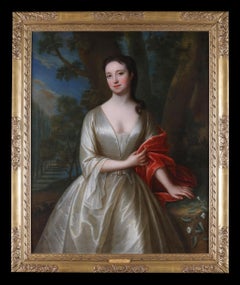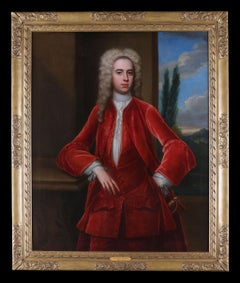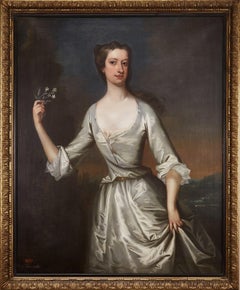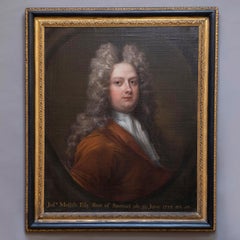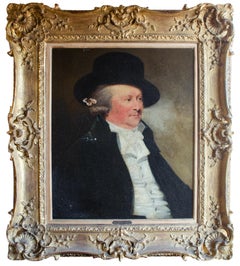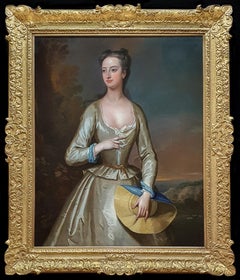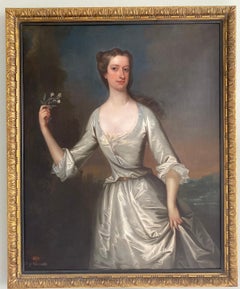Charles Jervas Portrait Paintings
Irish, 1670-1739
Charles Jervas was born in Dublin in 1675 who later lived in England. After moving to England, Jervas became an apprentice to the painter Sir Godfrey Kneller. He later studied drawing in Rome and then returned (c. 1709) to England. Succeeding Kneller, he became court painter to the English kings George I and George II. His home became a centre for literary figures, among them Alexander Pope and Jonathan Swift, whose portraits Jervas painted, in addition to that of George II (1728). He produced a translation of Miguel de Cervantes’s Don Quixote (published posthumously, with his surname spelled Jarvis, in 1742).(Biography provided by Everett Fine Art)
to
6
5
5
1
1
4
Overall Height
to
Overall Width
to
3
5
4
2
2
2
1
1
1
1
6
6
6
178
98
78
65
6
6
2
2
Artist: Charles Jervas
Portrait of a Lady possibly Frances Thynne, Lady Worsley 1673-1750 Oil on canvas
By Charles Jervas
Located in St. Albans, GB
Charles Jervas
Possibly Frances Thynne, Lady Worsley 1673-1750
Oil on Canvas
Picture Size: 50 x 40"
Outside Frame Size: 58 x 48"
1675 – 1739
Charles Jervas, who was born in Clonli...
Category
Early 1700s English School Charles Jervas Portrait Paintings
Materials
Oil
Portrait of a Man possibly Arthur Viscount Irwin, Temple Newsam Oil on canvas
By Charles Jervas
Located in St. Albans, GB
Charles Jervas
Possibly Arthur, 6th Viscount Irwin (Temple Newsam)
Oil on Canvas
Picture Size: 50 x 40"
Outside Frame Size: 58 x 48"
1675 – 1739
Charles Jervas, who was born in Cl...
Category
Early 1700s English School Charles Jervas Portrait Paintings
Materials
Oil
English 18th century portrait of Henrietta Pelham-Holles, Duchess of Newcastle.
By Charles Jervas
Located in Bath, Somerset
Portrait of Henrietta Pelham-Holles (née Godolphin) (1701-1776), Duchess of Newcastle, standing in a wooded landscape with a river beyond, three-quarter length wearing an ivory silk ...
Category
1720s Old Masters Charles Jervas Portrait Paintings
Materials
Oil, Canvas
Portrait Of 1st Baron Hawkstone, Sir Rowland Hill, Tory MP for Lichfield
By Charles Jervas
Located in Blackwater, GB
Portrait Of 1st Baron Hawkstone, Sir Rowland Hill, Tory MP for Lichfield (1705-1783)
by Charles JERVAS (1675-1739)
Large 18th Century portrait of Baron Hawkstone, Sir Rowland Hill,...
Category
18th Century Charles Jervas Portrait Paintings
Materials
Canvas, Oil
Portrait by Charles Jervas of Henrietta Pelham–Holes, Duchess of Newcastle.
By Charles Jervas
Located in Taunton, GB
This charming 17th Century half length portrait by Charles Jervas is believed to be of Henrietta Pelham–Holes, Duchess of Newcastle. The sitter is wearing a blue silk gown.
Circa 1700
Oil on Canvas
27 x 19 1/2 inches
68.5 x 49.5 cm
In a fine gilded carved wood frame.
ABOUT THE SUBJECT:
The sitter of svelte poise depicts grace and style. Stylistically taking the fancy of the moment with clearness and brilliancy in his flesh tints. Jervas work follows the English eighteen century tradition of portrait painting, epitomized by the likes of Kneller and Dahl.
Henrietta "Harriet" Pelham-Holles, Duchess of Newcastle upon Tyne, was the wife of British statesman and prime minister Thomas Pelham-Holles, 1st Duke of Newcastle. She was the daughter of Francis Godolphin, 2nd Earl of Godolphin, and Henrietta Churchill, 2nd Duchess of Marlborough. She was also the granddaughter of Sidney Godolphin, 1st Earl of Godolphin, as well as John Churchill, 1st Duke of Marlborough, and Sarah Churchill...
Category
Early 18th Century Old Masters Charles Jervas Portrait Paintings
Materials
Oil
Charles Jervas, Portrait of Joseph Mellish
By Charles Jervas
Located in London, GB
Charles Jervas (1675-1739)
Portrait of Joseph Mellish (1675-1733)
Oil on canvas; held in a carved period frame
Dimensions refer to size of frame.
Provenance: Blyth Hall, Nottinghamshire, England; by descent to Sir Andrew Buchanan of Hodsock Priory, Nottinghamshire
In 1635 John Mellish, a merchant tailor of London, bought the estate of Blyth in Nottinghamshire. His son, a wealthy Oporto merchant, dying unmarried, left Blyth in 1703 to a cousin, Joseph Mellish, who became one of Newcastle’s earliest and most important political supporters in the county. He went up to Clare College, Cambridge in 1692 and on to the Inner Temple the following year. He married Dorothea Gore, daughter of Sir William Gore...
Category
Early 18th Century Old Masters Charles Jervas Portrait Paintings
Materials
Oil
Related Items
Family Portrait of Children Large Oil Painting on Canvas
Located in Cirencester, Gloucestershire
The Family Portrait
British School, 20th century
(painted in an earlier style)
oil on canvas, unframed
canvas: 30 x 24 inches
provenance: private collection, England
condition: overa...
Category
20th Century English School Charles Jervas Portrait Paintings
Materials
Canvas, Oil
Portrait After John Constable, Sotheby's Provenance
By John Constable
Located in Larchmont, NY
After John Constable (British, 1776-1837)
Portrait of A Man, c. 1800
Oil on canvas
23 3/4 x 19 3/4 in.
Framed: 34 x 29 3/4 x 2 3/4 in.
Sotheby'...
Category
19th Century English School Charles Jervas Portrait Paintings
Materials
Canvas, Oil
Huge Antique Oil Painting Portrait of Mrs Boone & Daughter after lost original
Located in Cirencester, Gloucestershire
After SIR JOSHUA REYNOLDS
(1723 -1792)
Portrait of Mrs Boone and her Daughter
Oil on Canvas
Canvas Size : 55.25 x 43.25 inches (140 x 110 cms)
Framed size : 62 x 50 inches (157.5 x 127 cms)
Provenance : Private Collection, France
This present picture is a good quality copy of a Reynolds original. Copies are notoriously
difficult to date, but judging by the style and the materials used it is most probable that we are
dealing with a picture painted between 1890 and 1920. The professional standard of the work
makes this painting a fine and substantial piece of decoration in the 18th century English
manner. But in this case there is more…
The Reynolds original was painted around 1774-6 and depicts Harriet Boone, wife of Charles
Boone with their daughter, also Harriet – later the wife of Sir William Drummond K.C. This
picture was by 1865 in the collection of one T Colleton Garth (a relative of the younger
Harriet Boone), who lent it to an exhibition of Old Master pictures at the British Institution in
1865. It was engraved in 1866 by G.H. Emery – presumably after attracting some attention at
that exhibition. The painting was then bought from Garth by the dealers Agnew in 1903 and
sold the following year in 1904 to the famous Anglo-German diamond magnate Alfred Beit.
Two years later in 1906, Beit - who would fill his later years with numerous philanthropic
donations in Germany, England and South Africa - gave the Reynolds original of Mrs Boone
to the Berlin Gallery...
Category
Late 19th Century Old Masters Charles Jervas Portrait Paintings
Materials
Canvas, Oil
Portrait of an Elegant Lady in a Red Silk Dress, Beautiful Antique Frame c.1720
By Jonathan Richardson the Elder
Located in London, GB
This beautiful portrait was painted circa 1725 and is a fine example of the English eighteenth century portrait style. The artist has chosen to depict the lady against a plain background wearing a simple red silk dress and transparent headdress hanging down the back. The sitter is not shown with jewellery or any other elements to distract the viewer’s attached, thus highlighting the beauty of the young sitter. This restrained manner achieves a sense of understated elegance.
The portrait genre was valued particularly highly in English society. Neither landscapes nor allegorical pictures were ever priced so highly at exhibitions and in the trade as depictions of people, from the highest aristocracy to scholars, writers, poets and statesmen. With the rich colouring and lyrical characterisation, these works are representative of the archetypal English portrait and is are very appealing examples of British portraiture...
Category
18th Century Old Masters Charles Jervas Portrait Paintings
Materials
Canvas, Oil
H 37.41 in W 28.94 in D 1.97 in
Pair (2) Portraits Gentleman & Lady, William & Rachel Helyar c.1656, Civil War
By Robert Walker
Located in London, GB
Portrait of Colonel William Helyar (1621-1698) and Rachel Helyar (c.1633-1678) c.1656
Circle of Robert Walker (act. 1637-1656)
These fascinating portraits, presented by Titan Fine Art, depict Colonel William Helyar, High Sheriff of Somersetshire, and his wife Rachel Helyar nee Wyndham, a daughter and co-heiress of Sir Hugh Wyndham, 1st Baronet (died 1663) of Pilsden Court, Dorset. They are exquisite examples of portraiture during the Interregnum when England was under various forms of republican government.
The history of the seventeenth century is in part the story of the Stewarts and their approach to government and the church; their ebbing and flowing popularity and the disastrous decisions that led to Civil War. But another fascinating dynasty also ruled Britain: the Cromwell’s. Between 1653 and 1659, following the Civil Wars and experimental Commonwealth, Oliver Cromwell governed as Lord Protector followed by his son Richard. Cromwell’s Protectorate is usually imagined as a grey, joyless, military regime. But the reality was rather different. Cromwell presided over a colourful and fashionable court where music and the arts flourished, masques were revived and the first English operas performed. Too often the London of the 1650s is painted as puritanical and repressive in contrast to the vivid, fun-loving capital of the Restoration. Yet, under Cromwell, this was the city where the first coffee houses were opening, where a young Samuel Pepys was embarking on his career as a civil servant with the patronage of one of Cromwell’s councillors and where Christopher Wren was enjoying his new Chair of astronomy at Gresham College, appointed after the personal intervention of Cromwell. When Cromwell was invested as Lord Protector for the second time in 1657, the lavish ceremony in Westminster Hall and procession through London matched any previous coronation for pageantry with thousands lining the streets, bells ringing, bonfires blazing and free French wine flowing through the city.
The gentleman in our portrait is Colonel William Helyar (1621-1698), Sheriff of Somerset and as a Royalist during the English Civil War. As one of the most prominent old families of the South-West, the Helyar’s family roots in Somerset can be traced back to 1616 when the Reverend William Helyar (1559-1645), chaplain to Elizabeth I, who was also a cousin by marriage, purchased the family residence Coker Court in East Coker, Somerset. He married a Devonshire heiress and several estates were bestowed on him as a result. He was a warm supporter of Charles I in the Civil War and was in residence at Exeter in 1643 when the Parliamentarians pillaged the cathedral. Elderly as he was, he boldly resisted them, but was beaten, pelted with mud, and locked up in a ship in the port and only let out on payment of £800. He retired to Coker where he died in 1645. His eldest son Henry died in 1634 and he was succeeded by his grandson, Colonel William Helyar, the sitter in our portrait. Colonel Helyar raised a troop of horse for King Charles I and was a colonel in the king's army. He was at Exeter when it was captured by the Parliamentary forces in 1646 and thus deemed ‘Traitor to the Parliament’. His estates were sequestered, but they were returned and he was discharged and pardoned on payment of £1,522. During the Restoration he was a Sheriff and he also helped James II repel the Monmouth Rebellion.
The companion portrait represents the Colonel’s wife, Rachel Helyar (baptised 24th June 1633 at St Mary Aldermanbury, London – died 1678). She was the youngest daughter and co-heir of Sir Hugh Wyndham, 1st Baronet of Pilsdon Court and Mary Wyndham nee Alanson (Sir Hugh should not be confused with his first cousin once removed from Somerset, also Sir Hugh Wyndham (bef. 1604 - 1684). Rachel is a thirteenth generation descendant of King Henry III.
The couple resided at the family seat of Coker Court (interestingly, within the churchyard, lie the remains of the poet T.S. Eliot who once wrote a poem about East Coker). A marriage settlement in extant shows that the couple were married in 1656; the portraits were most likely painted to mark this important event in the sitter’s lives. Rachel holds roses, the flower of love, and the putto pouring water is representative of her purity, and possibly, the plighting of troth. Colonel Helyar wears a gold wedding band.
The couple had four sons: George, William (MP) (1662-1742), John, and Richard. Colonel Helyar died in December 1697 and was buried at Whitechurch, Dorset 2 Jan 1698.
This period in which this portrait was painted was known as the Protectorate (1653-1659). This period offered relative peace, as the English Civil War ended in 1651. It was an interesting time for portraiture in England and Scotland – in between the great artistic geniuses and dominance of Van Dyke and Peter Lely. Much of the foreign-born artistic talent had fled England and Scotland during the Civil War and the artists that had remained were in great demand, in part due to the newly exposed strata of society wishing to be painted. Sitters on both sides were depicted in portraits in very similar ways. They are not, on the whole, shown as the Roundheads and Cavaliers of popular history. In fact, it is usually impossible to guess their political allegiances from the style of their portrait and their Parliamentarian and royalist iconographies, as portraits on both sides followed the same conventions and looked identical.
Colonel Helyar has been depicted in armour and holding a Marshal’s baton of command, confirming his status. There is a great sense of realism and a particular delicacy, note the finely rendered hand resting on the rapier. Rachel is wearing a satin dress with expansive sleeves and a crimson drapery over her shoulder and held up by her left hand. She wears large pearl...
Category
17th Century Old Masters Charles Jervas Portrait Paintings
Materials
Canvas, Oil
H 51.97 in W 44.1 in D 1.97 in
18th Century French Portrait of Mysterious Man Oil on Canvas for restoration
Located in Cirencester, Gloucestershire
Portrait of a Gentleman
French School, 18th century
oil on canvas, unframed
canvas : 25 x 20 inches
provenance: private collection, France
condition: the painting is in sound conditi...
Category
18th Century Old Masters Charles Jervas Portrait Paintings
Materials
Oil
Continence of Scipio, Erasmus Quellinus, School Rubens, Baroque Art, Old Master
By Erasmus Quellinus the Younger
Located in Greven, DE
Erasmus Quellinus
The Continence of Scipio
Oil on Canvas
The painting is included in the Catalogue Raisonné of the artist.
The Roman commande...
Category
17th Century Baroque Charles Jervas Portrait Paintings
Materials
Oil, Canvas
Free Shipping
H 42.52 in W 64.18 in
CHERUBIM WITH FLOWERS- Italian School - Italian Figurative Oil painting
By Giulio Di Sotto
Located in Napoli, IT
Cherubim with flowers - Oil on canvas cm.80x100 by Giulio Di Sotto, Italy, 2002.
Gold leaf gilded wooden frame available on request
This wonderful oil on canvas represents two putti...
Category
Early 2000s Old Masters Charles Jervas Portrait Paintings
Materials
Canvas, Oil
Fine Large 1800's English Oil Country Gentleman in Parkland before Stately Home
Located in Cirencester, Gloucestershire
The English Gentleman and his Country House
English artist, circa 1800-1820 period
Fine Georgian period portrait of a young English gentleman, seated with distant view of his country...
Category
Early 19th Century English School Charles Jervas Portrait Paintings
Materials
Oil, Canvas
Large European Aristocratic Portrait of a Wigged Gentleman Oil Painting canvas
Located in Cirencester, Gloucestershire
Portrait of a Nobleman
European School, 20th century (painted after an earlier style)
oil on canvas, framed
framed: 35 x 29 inches
canvas: 30 x 24 inches
provenance: private collecti...
Category
20th Century English School Charles Jervas Portrait Paintings
Materials
Oil, Canvas
No Reserve
H 35 in W 29 in D 1 in
Portrait of a Lady in Silver Silk Dress & Pearls c.1660, Oil on canvas painting
Located in London, GB
This exquisite work is an accomplished example of the type of portrait in vogue in England during the third quarter of the 17th century. There was a large demand for paintings in England and the demand for portraits was greatest. Many artists worked in this lucrative field, even artists who initially trained in the more respected field of history painting, such as Peter Lely, turned their attention to portraiture to meet this demand. Moreover, it was not uncommon for the British, even for men, to present a gift of one’s portrait to a friend - portraits were first and foremost a memento.
Woman at court often vied with one another in displays of rich and fashionable clothing. The drapery was either painted from the customer’s own clothes or was perhaps a creation using fabrics loosely tacked together in the studio. This was a common practice of Lely and his studio props included swathes of fabric and pieces of cloth. The sitter’s sumptuous attire and gauze scarf, fastened by a large diamond brooch, is of the finest material and is representative of wealth. Pearls were an obligatory accompaniment since at least the 1630s and they are worn in abundance – in her hair, on her attire, as a necklace, and as pear-shaped earrings called unions d’excellence, reflecting the difficulty of finding perfectly matched pearls of such large size. They could range up to 20 millimetres in diameter. Her hairstyle help date the painting to the early 1660’s.
Peter Lely, the son of a Dutch...
Category
17th Century Old Masters Charles Jervas Portrait Paintings
Materials
Canvas, Oil
H 36.62 in W 30.71 in D 1.97 in
Portrait of Young English aristocrat with Straw Hat. English School circa 1720
Located in Firenze, IT
Portrait of a young aristocratic girl - 18th century English style
Oil on canvas.
Silvered wood frame.
Size with frame cm 85 x 72.5
Size without frame cm 74.5 x 62.5
At the hear...
Category
1720s English School Charles Jervas Portrait Paintings
Materials
Oil, Canvas, Wood
H 33.47 in W 28.55 in D 1.19 in
Previously Available Items
Portrait of Hannah Clements as a Shepherdess c.1730; by Charles Jervas
By Charles Jervas
Located in London, GB
This elegant and graceful portrait is said to represent Hannah Clements (1710-1781) nee Gore. Painted by Charles Jervas - who was in 1723 appointed to the post of King’s Painter by George I and in 1725 to George II - it is one of his finest and most impressive examples. Jervas was considered the supreme practitioner of female portraiture in the 1720s and 1730s, and was the foremost successor to Sir Godfrey Kneller after the latter's death in 1723. Presented in an outstanding carved and gilded antique frame, a remarkable work of art in itself.
The sitter is captured in a moment of relaxation in a country landscape. Jervas continued the idiom of Sir Godfrey Kneller, his master, whilst introducing a new ease and suggestion of informality into his portraits. By depicting the sitter within the landscape with sheep Arcadian simplicity is being suggested. This draws from the tradition of pastoral literature and by the early 17th century was already popular in art; all educated individuals were familiar with Latin and Greek pastoral poetry. The mythological world of Arcady was an idyll that the ladies and gentlemen of the Court could inhabit in the guise of shepherds and shepherdesses. The pastoral tradition in literature and plays had been embraced by an aristocratic class since classical times. Life in the country was perceived as peaceful, contemplative and free of worry of hardships, a time to pursue pleasure. To be painted in such a manner created a tangible expression of power and wealth. When the portrait was painted the pastoral was so ingrained that the mere inclusion of such elements suggested Arcadia to the viewer. And this is further emphasised by painting the light to reflect sunset and the suggestion of tranquillity. Of course, the sitter did not live in such a place and this masterful painting was a flight from chaos to a tranquil world.
Hannah Catherine Clements (nee Gore) (1710-1781) was the daughter of Rev. William Gore (and granddaughter of Sir William Gore, 3rd Baronet), and Honora Prittie. She married Nathaniel Clements (1705-1777), an important Irish politician and financial figure, in January 1730. Nathaniel became the main financial manager of the British and Irish Government in Ireland during the period, and was de facto Minister for Finance from 1740 to 1777. He had an extensive property portfolio, including Abbotstown, County Dublin, estates in County Leitrim and County Cavan and was developer of property in Dublin, including part of Henrietta Street where he lived at No. 7 from 1734 to 1757 in what was described as “Parisian luxury”. The couple had six children.
Charles Jervas was born in Clonliske in Kings Country, Ireland in 1675. He received his artistic training in Kneller’s studio and was later, by the 1690’s, Kneller’s assistant. According to Vertue Jervas made small copies of the Raphael cartoons, then at Hampton Court, in about 1698 and sold them to Dr George Clarke of All Souls, Oxford who lent him £50 to embark on the then essential ‘grand tour’ in 1699. Taking in Paris and settling in Rome by 1703, he furthered his artistic training and became a voracious copyist of the old masters. George Vertue noted that he was known as “Carlo Jervasi” and was a “good, engenious painter”. On his return to London in 1709 Tatler (15th April 1709) remarked that he was 'the last great painter Italy has sent us' and noted that he “painted many ladies as shepherdesses and country girls”. The style that he cultivated made him Kneller's natural successor when that artist died in 1723.
In 1727 he married a widow, Penelope Hume, a lady of considerable means (£20,000). In September 1738 he travelled to Italy seeking some reprieve from his asthma, returning in May 1739. He died in November that year and bequeathed £1000 to his friend, Pope, should he outlive his widow: this did not happen as she survived until 1747. The following spring his considerable art collection was sold in 2265 lots in a sale lasting 9 days.
Apart from royalty Jervas gained the patronage of many of the ruling and intellectual elite. He moved in the highest circles of the literary and social world and became an intimate of Sir Robert Walpole and the poet Alexander Pope, to whom he gave drawing lessons.
Jervas’ portrait of Elizabeth Felton, of Playford, Later Countess of Bristol (1677-1741) realised £45,410 at Christies London 11th June 2002, lot 13. His portrait of Lady Barbara North realised £42,050 at Christies London 11th July 2008, lot 55.
Titan Fine Art are pleased to offer this work, which is representative of the artist’s best work.
Provenance: Private collection, Beal House...
Category
18th Century Old Masters Charles Jervas Portrait Paintings
Materials
Canvas, Oil
H 60.24 in W 50.4 in D 3.15 in
English 18th century portrait of Henrietta Pelham-Holles, Duchess of Newcastle.
By Charles Jervas
Located in Bath, Somerset
Portrait of Henrietta Pelham-Holles (née Godolphin) (1701-1776), Duchess of Newcastle, standing in a wooded landscape with a river beyond, three-q...
Category
1720s Old Masters Charles Jervas Portrait Paintings
Materials
Canvas, Oil
Portrait of William Townshend
By Charles Jervas
Located in Bath, Somerset
Attributed to Charles Jervas (Ireland 1675-1739 London) Portrait of William Townshend (1702-1738), three- quarter length, standing in a landscape wearing a red velvet coat...
Category
18th Century and Earlier Old Masters Charles Jervas Portrait Paintings
Materials
Oil
Charles Jervas portrait paintings for sale on 1stDibs.
Find a wide variety of authentic Charles Jervas portrait paintings available for sale on 1stDibs. You can also browse by medium to find art by Charles Jervas in oil paint, paint, canvas and more. Much of the original work by this artist or collective was created during the 18th century and is mostly associated with the Old Masters style. Not every interior allows for large Charles Jervas portrait paintings, so small editions measuring 20 inches across are available. Customers who are interested in this artist might also find the work of Studio of Sir Peter Lely, and Sir Godfrey Kneller. Charles Jervas portrait paintings prices can differ depending upon medium, time period and other attributes. On 1stDibs, the price for these items starts at $12,104 and tops out at $19,172, while the average work can sell for $14,516.
